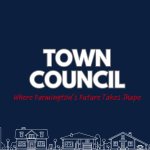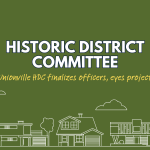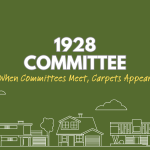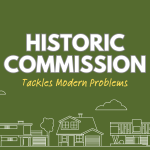Farmington, CT—In the heart of the bustling Farmington Historic District, a riveting meeting took place on July 23, 2024, that will undoubtedly go down in the annals of local history. With the room packed to the brim and an online audience watching with bated breath, the Farmington Historic District Commission gathered to deliberate on the pressing matters.
Shannon Rutherford, the town planner, commenced the proceedings with the roll call that only the truly dedicated can appreciate. “Good afternoon, everyone. I’m Shannon Rutherford, the town planner for Farmington. We’re going to start our meeting this afternoon for the historic district. I will start with a roll call of our members.”
The responses came swiftly:
- Joanne Lawson: “Here.”
- Jim Calciano: “Here.”
- Michelle Phelan: “Here.”
- Jay Bambara: “Here.”
- And alternate Ted Sanford: “Here.”
With the notable absences of Liz Gamsee and John Rennihan, the stage was set. Chairman Jay Bambara took the helm with a firm but fair grip, ready to steer this ship through the choppy waters of municipal discourse. “I’ll call the meeting to order and ask the secretary to read in the public notices of hearing,” he announced with an air of authority.
Bianca Signs and Dr. Kumar’s Saga
First on the docket was an application tabled from the June 18, 2024, meeting. Dr. Kumar, the proud new practice owner at 771 Farmington Avenue, took to the podium. “What I’m looking for from the committee here is that I need to do, you know, we have changed the inside of the building. It’s pretty much a new building. We want to put a good sign and we want to do it in this cycle.”
Representatives from Bianca Signs, Jocelyn, and Bianca herself joined via Zoom, navigating the digital frontier to assure the committee of their compliance and dedication to meeting the town’s standards.
The deliberations were intricate, with committee members probing the details:
- Joanne Lawson, ever meticulous, inquired about the dimensions and design specifics. “Could you confirm the exact dimensions and the material used for the signage?” she asked.
- Jim Calciano raised concerns about the alignment with planning and zoning standards. “Has this signage gone through P&Z?” he questioned.
- Jocelyn from Bianca Signs clarified, “No, sir. We discussed it under new business at the July 8th meeting with TPZ. It did not require a permit and was left with staff to continue.”
- Michelle Phelan wanted to know about the aesthetics. “Are the letters going to be painted on or raised?” she queried.
- “The letters will be painted on,” Jocelyn responded.
The discussion also touched on the font consistency, with Chairman Jay Bambara noting, “The font on the sign is different. Dentistry is in an antique font, while Family and Cosmetic is in a different one.”
Dr. Kumar, eager to comply, said, “I am not opposed to using a single font. Whatever you want, that’s fine.”
In the end, the motion to approve the temporary certificate of appropriateness, with a unified font style as noted by property owner Patrick Downer, passed unanimously. Dr. Kumar, grateful and humbled, expressed his thanks to the commission: “I really appreciate the committee, and we will once again if, you know, if you feel that we need to change something, we made a mistake, please let us know and we will replace it if we need to.”
St. James Episcopal Church’s Door Dilemma
Next, the commission turned its gaze to St. James Episcopal Church. Represented by Bob Seidel, the church sought approval for replacing six doors and one storm door. Bob, a beacon of historical knowledge and community spirit, laid out the church’s case: “Our present doors are 50-plus years old and are in need of replacement. We have found doors of similar design to the existing doors, especially those that face the street.”
Questions flew thick and fast:
- Joanne Lawson delved deep into the door specs, ensuring historical accuracy. “I drove around and looked at the pictures you presented. Can you confirm which doors are being replaced and with what materials?” she asked.
- Bob Seidel explained, “The doors are fiberglass and steel, depending on cost. The main door will be fiberglass.”
- Jim Calciano scrutinized the use of materials, particularly the balance between wood, fiberglass, and steel. “We typically approve wood doors. Why the switch to fiberglass and steel?” he inquired.
- Bob Seidel cited insulation and durability, “It’s for insulation purposes. From the street, you won’t be able to tell if they’re wood, metal, or fiberglass.”
- Michelle Phelan and Ted Sanford raised the critical issue of the door’s mullions and their authenticity. “Are the mullions between the glass panes or on the outside?” Ted pressed.
- Bob replied, “They’re between the panes for easier cleaning.”
- Ted expressed concern, “That’s a problem. We prefer true divided light for authenticity.”
Bob suggested, “Could we affix mullions to the outside of the glass? Would that satisfy the commission?”
- Ted nodded, “That would be acceptable, but we also need to see how the glass is installed in the doors. Can you provide samples or photos?”
The commission, ever diligent, called for more information and samples. They continued the matter to the September meeting, giving the church time to meet the exacting standards of Farmington’s historical guardians.
The Hartford Baking Company Conundrum
The meeting wrapped up with a discussion on unauthorized work done at the Hartford Baking Company. Chairman Jay Bambara and the rest of the committee expressed their concerns about unapproved ductwork visible from public ways. An urgent plea was made for the property owner to submit the necessary paperwork posthaste.
As Shannon Rutherford explained, “A building permit should have been issued for this work. A certificate of appropriateness is needed, and I’ve informed the owner of these requirements.”
Chairman Bambara summed up the sentiment of the committee, “We appreciate the importance of central air, but modifications visible from public ways must adhere to our guidelines. We hope to resolve this promptly.”
Closing Thoughts and Gratitude
As the meeting adjourned, one thing was clear: Farmington’s historic district was in good hands. The committee’s dedication to preserving the town’s charm and character shone through every deliberation, every query, and every decision.
Before we sign off, a heartfelt thanks to our sponsor, Farmington Storage, located at 155 Scott Swamp Road. Need extra space? Give them a call at 860.777.4001. They keep Farmington’s treasures safe, much like our historic commission keeps our town’s heritage intact.
Stay tuned, dear readers, for more updates from the frontlines of historic preservation right here in Farmington.
-JB-












